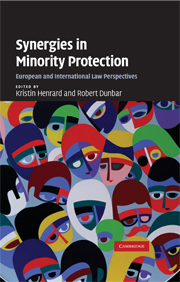Book contents
- Frontmatter
- Contents
- Foreword
- Abbreviations
- 1 Introduction
- PART A Minorities-specific instruments, provisions and institutions
- PART B Non-minorities-specific instruments, provisions and institutions
- 7 Developments relating to minorities in the law on genocide
- 8 The United Nations International Covenant on Economic, Social and Cultural Rights
- 9 The United Nations International Convention on the Elimination of All Forms of Racial Discrimination
- 10 The United Nations Convention on the Rights of the Child and Children Belonging to Minority Groups
- 11 UNESCO's Convention Against Discrimination in Education
- 12 A patchwork of ‘successful’ and ‘missed’ synergies in the jurisprudence of the ECHR
- 13 The many faces of minority policy in the European Union
- 14 Developments under the African Charter on Human and Peoples' Rights relevant to Minorities
- 15 Regional cooperation and minority issues in the Asia-Pacific region
- Index
- References
11 - UNESCO's Convention Against Discrimination in Education
from PART B - Non-minorities-specific instruments, provisions and institutions
Published online by Cambridge University Press: 21 July 2009
- Frontmatter
- Contents
- Foreword
- Abbreviations
- 1 Introduction
- PART A Minorities-specific instruments, provisions and institutions
- PART B Non-minorities-specific instruments, provisions and institutions
- 7 Developments relating to minorities in the law on genocide
- 8 The United Nations International Covenant on Economic, Social and Cultural Rights
- 9 The United Nations International Convention on the Elimination of All Forms of Racial Discrimination
- 10 The United Nations Convention on the Rights of the Child and Children Belonging to Minority Groups
- 11 UNESCO's Convention Against Discrimination in Education
- 12 A patchwork of ‘successful’ and ‘missed’ synergies in the jurisprudence of the ECHR
- 13 The many faces of minority policy in the European Union
- 14 Developments under the African Charter on Human and Peoples' Rights relevant to Minorities
- 15 Regional cooperation and minority issues in the Asia-Pacific region
- Index
- References
Summary
Introduction
The United Nations Educational, Scientific and Cultural Organisation (‘UNESCO’) is well known for its activities that promote the right to education, the freedom of expression and the cultural rights of individuals and groups. Member states of UNESCO have also adopted Conventions and recommendations that aim at the promotion and protection of the human rights that fall within the organisation's mandate. One of these Conventions deals with the right to education. The Convention Against Discrimination in Education (‘CADE’) was adopted in 1960. It is rather obscure, owing to its relatively small number of states parties, its weak supervisory system and the difficulty of getting access to Convention documents. According to its preamble, the main purpose of the Convention is to proscribe any form of discrimination in education and to promote equality of opportunity and treatment for all in education. In addition to provisions that lay down in detail general obligations of states parties to realise the purposes of the treaty, the Convention recognises the right of members of national minorities to carry on their own educational activities. After discussing the features of the Convention and its monitoring procedure, this chapter will analyse the meaning of the minority rights provision and ask whether that provision has been given substance by the Committee on Conventions and Recommendations. This is the body that monitors implementation of the Convention's provisions by UNESCO member states.
- Type
- Chapter
- Information
- Synergies in Minority ProtectionEuropean and International Law Perspectives, pp. 297 - 313Publisher: Cambridge University PressPrint publication year: 2009



